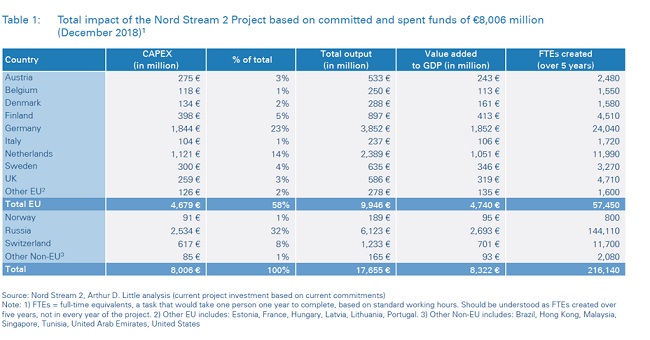Analytics, Baltic States – CIS, Construction, Economics, Energy, EU – CIS, Gas Market , Russia
International Internet Magazine. Baltic States news & analytics
Thursday, 18.04.2024, 10:15
Survey: Nord Stream 2 major infrastructure project has a total economic benefit to the EU of €9.9 bn
 Print version
Print versionIn comparison to the first report (2017), which was carried out in the procurement phase, more than twice as much CAPEX has now been committed and spent in several EU and non-EU countries now that the project is in the middle of construction. More than 1,000 contractors from all over Europe and Russia are contributing to the realization of the project. This includes both large international firms providing materials or construction services and small enterprises providing expert services. Furthermore, the investment until the end of December 2018 creates 57,500 full-time job equivalents in the EU over five years, adding 4.7 bn EUR in GDP in various industrial sectors.
Nord Stream 2 is a major natural gas infrastructure project that aims to build a pipeline system with 55 bcm per year of transport capacity. It will safely and reliably export gas to the European market, where demand is stable but indigenous production is decreasing, creating an import gap.
The objective of the new Arthur D. Little study, commissioned by Nord Stream 2, is to understand the direct, indirect and induced effects of the project on the European economy, and on countries where actual investments in the pipeline have been or are being made in more detail. Compared to the previous report, the current one takes actual spent and detailed supplier data until the beginning of operations into account.
It estimates the effects related to the execution of the project, as well as those on supply chains and the wider economy. The analysis used an economic modeling tool (IMPLAN) based on underlying statistical databases for different economies. The study considers all committed and spent investments as of the end of December 2018 of (CAPEX) 8 bn EUR.
The most pronounced effects are seen in countries where major project-related construction activities taking place – Russia, Germany, Finland, Denmark and Sweden; in countries traditionally associated with the offshore oil and gas industry that host the majority of service providers – the Netherlands, the United Kingdom, Norway and Italy; and at the headquarters of the project developer and other international service providers. The current study was complemented with supplier interviews which confirmed the beneficial impact the project has had on corporate development and local communities. Also highlighted in the study were some of the major innovations and pioneering solutions for challenges that resulted from project work.
Michael Kruse, Partner in ADL’s Energy & Utilities Practice, said: “At a time when the oil and gas industry is experiencing cut-backs and lay-offs, this report transparently demonstrates the benefits of large energy infrastructure projects such as Nord Stream 2.”
The report can be downloaded here: www.adl.com/EISNordStream2









 «The Baltic Course» Is Sold and Stays in Business!
«The Baltic Course» Is Sold and Stays in Business!

